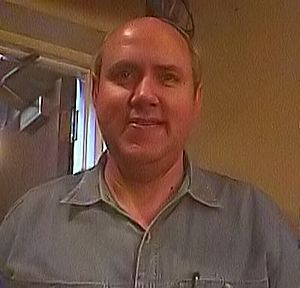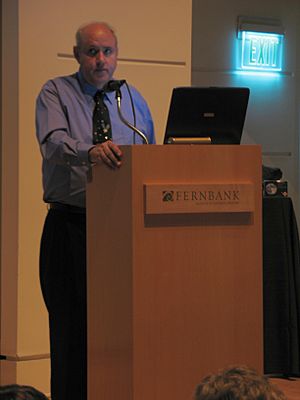Thomas Bopp facts for kids
Quick facts for kids
Thomas Bopp
|
|
|---|---|
 |
|
| Born | October 15, 1949 Denver, Colorado, U.S.
|
| Died | January 5, 2018 (aged 68) Phoenix, Arizona, U.S.
|
| Alma mater | Youngstown State University |
| Occupation | Professional speaker, amateur astronomer |
| Known for | Co-discovery of comet Hale–Bopp with Alan Hale |
Thomas Joel Bopp (born October 15, 1949 – died January 5, 2018) was an American amateur astronomer. This means he studied stars and space as a hobby, not as his main job. In 1995, he made a huge discovery: a comet that was later named comet Hale–Bopp.
Another astronomer, Alan Hale, found the same comet at almost the same time. That's why it was named after both of them! When he found the comet, Thomas Bopp worked at a factory that made building materials. He was also a very dedicated amateur astronomer. On the night of July 22, 1995, Bopp was looking at the sky with his friends in the Arizona desert. He used a telescope that he had borrowed from a friend. This was the very first comet he had ever seen!
Contents
Early Life and His Love for Space
Thomas Bopp was born on October 15, 1949, in Denver, Colorado. A year later, his family moved to Youngstown, Ohio. When he was just three years old, his dad, Frank Bopp, showed him the wonders of the night sky. They watched a meteor shower from their porch. His dad taught him about planets, constellations, and the beautiful aurora borealis (also known as the Northern Lights).
When Thomas was ten, he got his very first telescope. It was a four-inch reflector telescope.
School and Air Force Days
Bopp went to Chaney High School and finished in 1967. After high school, he joined the United States Air Force. He served in the Philippines, where he saw the "green flash" several times. This is a rare optical event that happens just as the sun sets.
After 18 months, he moved to Davis–Monthan Air Force Base in Tucson, Arizona. There, he met Charlotte, who would become his wife. He left the Air Force in 1972. Soon after, they got married and had a daughter named April.
Learning More About Astronomy
Bopp then went to Youngstown State University. He studied business, but he also took many classes in physics and astronomy. He met two important professors there: Dr. Edwin Bishop and Dr. Warren Young. They encouraged him to join the Mahoning Valley Astronomical Society (MVAS) in Warren, Ohio.
He went to meetings often and became friends with astronaut Ronald A. Parise. He loved looking at deep sky objects with the club's large 16-inch Newtonian reflector telescope.
How Comet Hale–Bopp Was Found
In 1980, Thomas Bopp moved to Phoenix, Arizona. He worked for a construction company, but he kept going to astronomy clubs. He joined a group called the North Phoenix Alternative Astronomical Society. This was a casual group of space fans who met in the Arizona desert to observe the stars.
Even though he had tried many times, Bopp had never seen a comet before 1995. At this time, he was using a 17.5-inch reflecting telescope that belonged to his good friend, Jim Stevens.
The Night of Discovery
On the night of July 22, 1995, eight members of the club met near Vekol Ranch, about ninety miles south of Phoenix. As usual, Stevens and Bopp were sharing time looking through Stevens's telescope. Stevens had set up his newest homemade telescope. He decided to look for globular clusters (groups of stars packed tightly together).
Stevens pointed his telescope at Messier 70 (M70) in the Sagittarius constellation. Around 11 p.m., he called Bopp over to look. Bopp looked into the telescope and asked, "What's this other object?" Stevens replied, "You might have something there, Tom." Bopp later said it looked like "a little fuzzy glow." He first thought it might be a galaxy.
On the very same night, a professional astronomer named Alan Hale saw the same fuzzy object from his home in Cloudcroft, New Mexico. He was waiting for another comet to appear.
Confirming the Discovery
Bopp and his friends checked star charts. They watched the object for an hour to see if it was moving. Bopp and another friend, Bertie Sanden, drew its position compared to nearby stars. When they saw it was moving, Bopp knew it was a comet!
Bopp tried to contact the Central Bureau for Astronomical Telegrams (CBAT) at the International Astronomical Union (IAU). This organization records all new astronomical sightings and names them. But his cell phone didn't work in the desert. He drove towards home, stopping at a public payphone, but he didn't have the number. Finally, at home, Bopp sent a telegram to the IAU. Alan Hale had already sent three emails with the comet's location.
The next morning, the CBAT office called Bopp back to confirm his sighting. It was indeed a new comet! The comet was first called Comet 1995 O1. Three days later, it got its full name: C/1995 O1 (Hale–Bopp). Hale's name came first because his report arrived first. It's hard to say who saw it first, as they both spotted it around the same time.
The day after the confirmation, Alan Hale called Bopp. He said, "I think that we have something in common." When they met at a conference two months later, Bopp told the press he was happy that Hale "turned out to be a nice guy."
Life After the Big Discovery

After finding the comet, Thomas Bopp became very popular! He was asked to appear on TV and radio shows and speak at conferences. One of his appearances was on the children's science show Bill Nye The Science Guy. On March 21, 1997, Hale and Bopp were even named ABC Person of the Week.
Bopp once said, "I thought that it would be a comet that would be mentioned in the back of some obscure textbook somewhere, but it's certainly not turned out to be that way." As Hale–Bopp became more famous, Bopp left his factory job. He became a full-time speaker and educator. He loved visiting schools, science centers, and museums. He enjoyed sharing his passion for astronomy with children. He even met up with Alan Hale in Queensland, Australia, while taking a group of schoolchildren to see a solar eclipse in 2012.
In 1997, Bopp was invited to be an observer at White Sands Missile Range. A special rocket was launched to study the comet and look for certain elements. New types of elements were found, along with a third "sodium tail" on the comet!
Youngstown State University gave Bopp an honorary doctor of Science degree in 1998. Bopp and his father also became the first two members of the Friends of Ward Beecher Planetarium at the university.
In 1997, when Comet Hale–Bopp was at its brightest, Bopp experienced a very sad family event. He told a National Geographic reporter, "This has been the best week of my life. And the worst."
An Asteroid Named After Them
An asteroid was named after Thomas Bopp and his father Frank! It's called (7086) Bopp. It was discovered on October 5, 1991, by Carolyn and Gene Shoemaker. The Shoemakers were famous for finding another comet, comet Shoemaker–Levy 9.
In 1997, Gene Shoemaker passed away. His ashes were sent to the Moon, along with an image of Comet Hale-Bopp. This was because Hale-Bopp was the last comet the Shoemakers observed together.
Thomas Bopp said that even though Comet Hale–Bopp would disappear from view for about 2,380 years, he would always keep looking up at the stars. He continued to volunteer at observatories near Phoenix, Arizona, talking about Hale–Bopp. He passed away on January 5, 2018, at the age of 68, due to a health issue.
See also
 In Spanish: Thomas Bopp para niños
In Spanish: Thomas Bopp para niños


